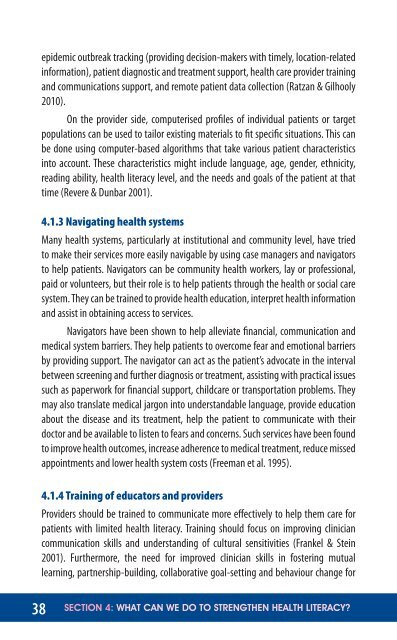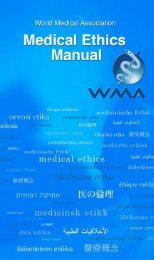the basics - World Health Communication Associates
the basics - World Health Communication Associates
the basics - World Health Communication Associates
- No tags were found...
Create successful ePaper yourself
Turn your PDF publications into a flip-book with our unique Google optimized e-Paper software.
epidemic outbreak tracking (providing decision-makers with timely, location-relatedinformation), patient diagnostic and treatment support, health care provider trainingand communications support, and remote patient data collection (Ratzan & Gilhooly2010).On <strong>the</strong> provider side, computerised profiles of individual patients or targetpopulations can be used to tailor existing materials to fit specific situations. This canbe done using computer-based algorithms that take various patient characteristicsinto account. These characteristics might include language, age, gender, ethnicity,reading ability, health literacy level, and <strong>the</strong> needs and goals of <strong>the</strong> patient at thattime (Revere & Dunbar 2001).4.1.3 Navigating health systemsMany health systems, particularly at institutional and community level, have triedto make <strong>the</strong>ir services more easily navigable by using case managers and navigatorsto help patients. Navigators can be community health workers, lay or professional,paid or volunteers, but <strong>the</strong>ir role is to help patients through <strong>the</strong> health or social caresystem. They can be trained to provide health education, interpret health informationand assist in obtaining access to services.Navigators have been shown to help alleviate financial, communication andmedical system barriers. They help patients to overcome fear and emotional barriersby providing support. The navigator can act as <strong>the</strong> patient’s advocate in <strong>the</strong> intervalbetween screening and fur<strong>the</strong>r diagnosis or treatment, assisting with practical issuessuch as paperwork for financial support, childcare or transportation problems. Theymay also translate medical jargon into understandable language, provide educationabout <strong>the</strong> disease and its treatment, help <strong>the</strong> patient to communicate with <strong>the</strong>irdoctor and be available to listen to fears and concerns. Such services have been foundto improve health outcomes, increase adherence to medical treatment, reduce missedappointments and lower health system costs (Freeman et al. 1995).4.1.4 Training of educators and providersProviders should be trained to communicate more effectively to help <strong>the</strong>m care forpatients with limited health literacy. Training should focus on improving cliniciancommunication skills and understanding of cultural sensitivities (Frankel & Stein2001). Fur<strong>the</strong>rmore, <strong>the</strong> need for improved clinician skills in fostering mutuallearning, partnership-building, collaborative goal-setting and behaviour change for38SECTION 4: WHAT CAN WE DO TO STRENGTHEN HEALTH LITERACY?






